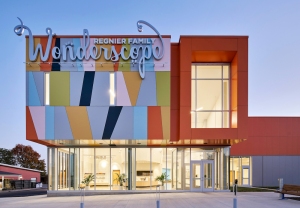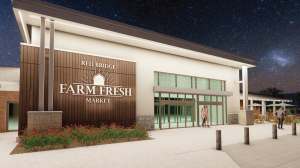We Shouldn’t Forget Our History, Or Those Who Came Before
You have to wonder about architects. Do they just see a vision in their minds of what a building should look like and then sell that concept to their client, convincing them that it’s the way to go matter what?

Red Bridge Shopping Center is a prime example. It was built in 1959 as a welcoming neighborhood shopping center with a primarily brick facade. Then in 2020 Wonderscope was built on the northwest corner of the Center. Mostly glass and bright colors in geometric designs, its three stories stick out like a sore thumb. Coming from the east on Red Bridge Road, you can see the roof from over a mile and a half away, looking like a blight on the treetops.

More recently, everyone has become excited about the new grocery store to be built soon. According to “The Telegraph”, “The new store front will mirror the architectural aesthetics and ambiance of the shopping center.” From the picture provided, it seems to be very angular and while there seems to be some wood veneer which echoes the somberness of the rest of the center, there is much more light coloring to this building. To “mirror…” they really should use brick. Maybe the goal here is to help tie in to the Wonderscope building which is somewhat kitty-corner to the grocery?
Whatever the reasoning is for either of these buildings’ exterior, it certainly would have been more admirable to consider the history of the area itself. Just to the east, between the shopping center and the Blue River, is a National Park Service informational exhibit marking actual swales (ruts) left by the wagon wheels of those who crossed the river on what has become known as the Three Trails (Oregon, Santa Fe, and California). This trail alignment then goes roughly down Holmes, passing Red Bridge Shopping Center. With all the pavement in the area today, it’s difficult to know the exact trail route, so there’s every possibility it actually crossed shopping center land.
The owners of this property should be proud of the heritage of the area and its contribution to emigration, trade, and mining; and that should be reflected in the architecture to better help us all remember.
Mike 1:59 pm on February 4, 2024 Permalink |
The prolonged demolition and desecration of the Red Bridge Shopping Center has been going on for decades. Originally, the main building and the surrounding buildings all had the same architectural features, which celebrated the Three Trails history of the Red Bridge area. When the Mid-Continent Public Library moved out of the main building to their own building across the parking lot, the same style was used. About the same time, Payless (a grocery) moved out of the main building to their own place (which later became Sun Fresh), and they at least incorporated the brick facade and wooden posts, though they broke with tradition on the roofing.
Then things went horribly wrong.
The restaurant building was demolished and the surrounding big sycamore trees removed. The service station was demolished. On the footprints of those buildings were constructed two cookie-cutter type structures right out of “Suburban Blight Illustrated”. And since they are next to the road, they present an imposing and appalling wall of ugliness, obscuring the original main building with its beloved Red Bridge charm.
But the main building was not to be spared.
In this Century, the new owner of the shopping center neglected everything except planting roses in the parking lot. How he raved about his fucking Knock Out Roses. And he set up a so-called Community Improvement District to defray the costs of maintaining the place (like removing snow from the parking lot) and did nothing to improve the actual structure (like fixing the leaking roof).
Then the subsequent owner imposed his love of the Cape Cod architectural style on the original Frontier style. The result is stupefyingly jarring.
So, these latest plans for renovating the grocery store are part of a trend that goes back to the time when local civic leaders (the Center Planning and Development Council) fell asleep and let atrocity after atrocity take place.
It’s hard to tell developers to start respecting the history and aesthetics of the area now, after all that. And it’s a real shame, because the shopping center, and its tie-in to Minor Park, where the original Red Bridge stood (and where now stands a freeway-sized bridge that tears us away from the park), could have been a part of greater whole, all based on the outstanding natural setting and historic legacy that we once had.
LikeLike